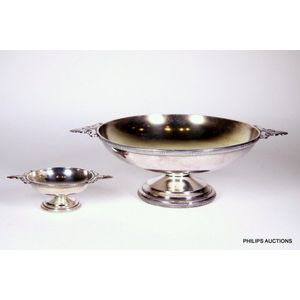Sheffield Silver Pedestal Dish, 1928
You must be a subscriber, and be logged in to view price and dealer details.
Subscribe Now to view actual auction price for this item
When you subscribe, you have the option of setting the currency in which to display prices to $Au, $US, $NZ or Stg.
- Faceting - Faceting is a technique of removing material from a curved surface, to give a series of flat surfaces but retaining the profile of the original surface.
The technique is most commonly associated with diamond cutting where the various cuts used such as rose cut and brilliant cut, add life and sparkle to the stone, whilst at the same time removing as little of the stone as possible.
Faceting by grinding is also used to decorate glass. The stems of many drinking glasses are decorated by cutting a series of flat surfaces on a circular stem, and hollow vessels such as vases may have faceted surfaces.
In furniture faceting is often applied to legs of tables and chairs, where a circular baluster shaped section is flattened so as to form an octagonal section. - Sterling Silver - Sterling silver is a mixture of 92.5% pure silver and 7.5% of another metal, usually copper. Fine silver is 99.9% pure silver, and is relatively soft and the addition of the very small amount of copper gives the metal enough strength and hardness to be worked into jewellery, decorative and household objects.
- Hallmarks - A mark stamped on articles of precious metals in Britain, since the 14th century, certifying their purity. It derives its name from the Guild Hall of the Goldsmiths' Company, who recieved its Charter in 1327 giving it the power to assay (test the purity) and mark articles of gold and silver.
The hallmark will consist of several marks, including the:
- silver standard mark, indicating the purity of the metal. Sterling silver is .925 pure silver.
- the city mark indicating the city in which it was assayed eg London, Birmingham, York etc.
- the date mark, usually a letter of the alphabet in a particular font and case,
- a duty mark, indicating whether duty had been paid to the crown, and only in use from 1784 to 1890
The piece may include an additional mark, the maker's mark, although not forming part of the hallmark, will be located in the vicinity of the hallmarks.
Sometimes silver plated items will bear faux hallmarks, often confusing those not familiar with silver markings.
Visually similar items

An elegant sterling silver pap boat, 1934 Birmingham, with maker's mark for S. Blanckensee & Sons Ltd. the elegant slender boat raised on an oval threaded foot rim, with a ring handle; hallmarked to the upper body. Silver weight 67gr. Height 4 cm. Width 16

A European silver comport, late 19th to early 20th century, no silver marks but X-ray tested for.800 silver. An oval dish within an integrated shaped rectangular frame with scroll, pineapple and fan shaped handles, classical female profiles to each corner,

A Continental silver plated comport and eleven small dishes, early to mid 20th century, a dessert service comprising a circular gilded dish with gadrooned edges to the bowl and foot, and twin cast handles with palmettes and scrolls, the small bowls conform

A small Arts and Crafts Georg Nilsson bowl, with purchased date 1933 and ONIRSA, plain beaten silver bowl on collar foot. Diameter 10 cm
